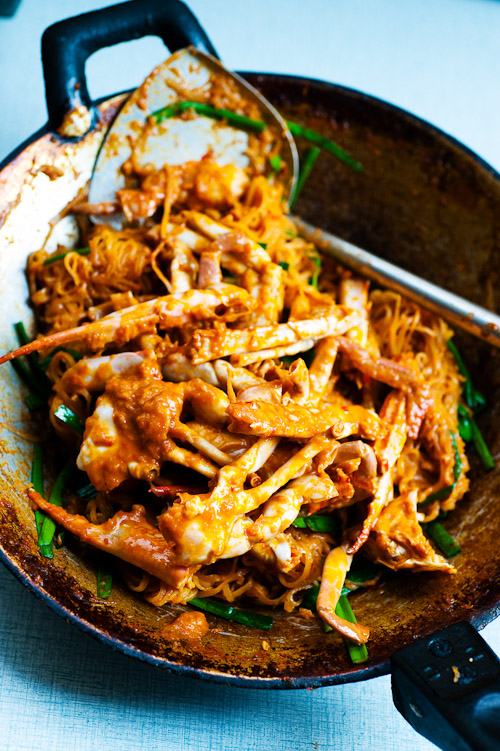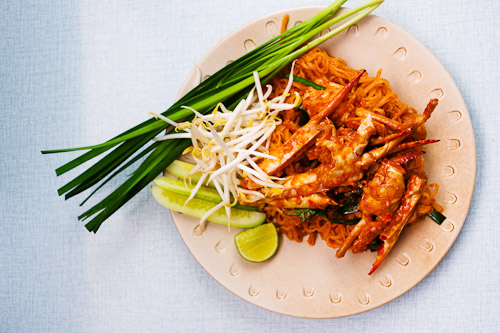 Kuaytiaw phat puu, rice noodles fried with a curry paste mixture and crab, is a signature dish of Chanthaburi. Despite this, it's only available at a couple places in the town, most of which are take-away only.
Kuaytiaw phat puu, rice noodles fried with a curry paste mixture and crab, is a signature dish of Chanthaburi. Despite this, it's only available at a couple places in the town, most of which are take-away only.
It took a bit of sleuthing, but I was eventually able to locate a lone stall in the city's market, and bought a bag:
Eating the noodles at a roadside coffee stall, I found them rich and slightly sweet, trailed by a barely-there spiciness. I liked the dish, and thought it had the added benefit of being easy to make for those who don't have access to obscure Thai ingredients. In searching the internet, I found two alternate versions of the recipe: one in which the crabs and then the curry paste are fried in oil before adding the noodles, and another in which the curry paste and crabs are simmered in coconut cream. I decided to go with the latter. If you can read Thai, the recipe upon which this is based can be seen here (the Thai script can't be viewed in Firefox for some reason). If you want to keep it authentic, try to find the famous sen chan, rice noodles from Chanthaburi, otherwise any thin rice noodles will do.
Kuaytiaw Phat Puu (Chanthaburi-style fried noodles with crab)
Large dried chilies, six, soaked in warm water until soft Shallots, 5, peeled Garlic, 6 large cloves, peeled Shrimp paste, about 2 Tbsp
Coconut cream, about 2 cups Dried thin rice noodles, 250g Tamarind paste, to taste Fish sauce and/or salt, to taste Palm sugar, to taste Ketchup, to taste Four swimmer crabs (about 750g), prepared and quartered Chinese chives, 1 small bunch, chopped into lengths of about 3cm
Lime, sliced Chinese chives, 2 small bunches Bean sprouts, about 1 cup Baby cucumber, four, sliced thinly
Make a curry paste by grinding chilies, shallots, garlic and shrimp paste in a mortar and pestle until fine. Set aside.
Bring coconut milk to a simmer a wok over med-low heat. Add curry paste, stirring to combine. Lower heat slightly, being careful not to allow coconut cream to boil, and simmer until liquid is reduced slightly and mixture is well-combined and fragrant, about 10 to 15 minutes.
While mixture is simmering, soak noodles in water until soft and flexible, about 10 minutes.
Season coconut cream mixture to taste with tamarind paste, fish sauce, sugar and ketchup; it should be somewhat sweet and sour, slightly less salty and spicy. Allow to simmer another 10 minutes or so until the flavours have combined. Add crab and simmer until cooked, another 5 minutes.
Pour mixture, including crab, into a large bowl. Return about 3/4 cup of the liquid back to the wok, followed by about 1/3 of the noodles. Fry, stirring to combine, adding water, if necessary, to prevent the noodles from sticking. The noodles can get pretty gloopy at this point; to avoid this, simply fry smaller portions. When noodles are soft and have absorbed the liquid, add 1/3 of chopped chives 1/3 of crab, stir to combine and serve, accompanied by a slice of lime, a couple stalks of Chinese chive, bean sprouts and sliced cucumber.













